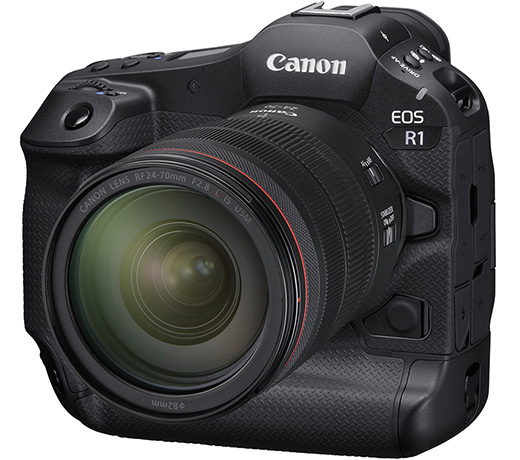 Japan
Japan Americas
Americas Europe, Asia, Oceania
Europe, Asia, Oceania
- Outline
| Marketed | November 2024 |
| Original Price | Open price |
| Specifications | Open PDF (504KB)  |
The EOS R1 is a full-frame mirrorless camera which inherits the strong reliability and durability of the EOS-1D X Mark III while also boasting advanced shooting capabilities. Through the “Accelerated Capture” system, which combines the DIGIC X image processor with the newly developed DIGIC Accelerator processor and a full-frame, back-illuminated stacked CMOS sensor, as well as the use of deep learning technology, it achieves the level of still image and video performance sought in a flagship model and satisfies the strong demands of professional users.
Users can quickly adjust the focus and persistently track the target subject, supported by further improved tracking performance, which is achieved through the combination of the above features, to accurately track the movement of target subjects. This superb tracking performance is also aided by an “Action Priority”*1 function that recognizes certain actions such as shooting a soccer ball and instantly shifts the AF frame, and an Eye Control AF*2 function that has been updated since its inclusion in the EOS R3. Additionally, as a first for the Dual Pixel CMOS AF system, the device is equipped to handle Cross AF*3, thereby reducing the impact of patterns on the subject or obstacles and producing stable shots clearly focused on the subject.
The product boasts advanced continuous shooting and is equipped with a newly developed electronic viewfinder. When using the electronic shutter, the EOS R1 achieves a maximum shutter speed of approximately 40fps and also reduces rolling shutter distortion significantly to nearly the same level as the EOS-1D X Mark III when using a mechanical shutter. It also contains a “Pre-continuous Shooting”*4 function that enables continuous shooting for up to roughly 20fps, tracing back from the moment the shutter button is pressed. In addition to these functions, in order to assist with optimal shooting, the device includes a newly developed electronic viewfinder with approximately 9.44 million dots, the highest number in the EOS Series, as well as finder magnification of approximately 0.9 and the highest degree of brightness in the EOS Series so that users can capture decisive moments in various environments.
The camera achieves its excellent image quality thanks to a new sensor and internal data processing. Through the use of a newly developed full-frame, back-illuminated stacked CMOS sensor with up to roughly 24.2 effective megapixels*5, it covers normal ISO sensitivity from 100-102400 (when shooting still images), thus enabling high-quality shooting across a wide range of scenarios from capturing sports in bright outdoor settings to filming news reports at night. Additionally, the “in-camera upscaling”*6 function can generate images with up to roughly 96 megapixels in-camera and can even be used for cropping images without the use of applications, etc.
*1 Only for still images and when electronic shutter is in use. Recognition accuracy may be reduced if people shown in frame are far away, subjects are partially hidden, or multiple subjects are clustered together. Applicable sports are soccer, basketball, and volleyball.
*2 Requires calibration in advance. Eye Control AF may be unavailable when users are wearing sunglasses, visor sunglasses, or bifocals, or due to individual differences in eye condition (such as narrow eyes, long eyelashes, or thick eyelids) or shooting environment.
*3 Only for still images. Only in H/L mode during continuous shooting when electronic first curtain and mechanical shutter are in use. Excluding usage with Pre-AF and Focus Guide.
*4 Not available when shutter speed is slower than 0.5 sec. AEB shooting, flash photography, anti-flicker shooting, focus bracketing, and multiple-exposure shooting are also not possible.
*5 Number of effective pixels may decrease due to the lens being used or image processing.
*6 Image processing may take time. In-camera upscaling cannot be used on still images recorded when capturing video.


